Parasites Infect Bees Exposed to Pesticides and Fungicides

As more bees continue to mysteriously die, a recent study points to a combination of pesticides and fungicides as contributing factors in the condition known as Colony Collapse Disorder, which has killed millions of bees worldwide.
The study, conducted by the USDA along with researchers at the University of Maryland and published in the journal PLOS One, found that where pollen was contaminated with both fungicides and pesticides, the bees were less capable of resisting a parasitic infestation (Nosema ceranae) believed to be causing the bees to abandon their hives and die.
According to the research, the pollen samples contained traces of nine pesticides and fungicides, on average. One sample tested positive for more than 20 types of pesticides and fungicides. Of the chemicals found on the pollen, eight were associated with an increased risk of the parasitic infection. And, the researchers noted, when bees ate the contaminated pollen, their risk of becoming infected with the parasite increased three times.
Pollen samples collected from wildflowers were also found to contain traces of pesticides and fungicides. It wasn’t clear if the contamination was a result of chemical drift or if the plants were also being intentionally sprayed.
“There’s growing evidence that fungicides may be affecting the bees on their own and I think what it highlights is a need to reassess how we label these agricultural chemicals,” Dennis vanEngelsdorp, the study’s lead author, told Quartz.
The European Union has recently banned four pesticides believed to be directly connected with bee die offs: three types of neonicotinoids and fipronil.
Bees are vital in agriculture, doing billions of dollars worth of pollination for free. It’s estimated that one out of every three bites of food is a result of bee pollination.
Keep in touch with Jill on Twitter @jillettinger
Image: ecstaticist

